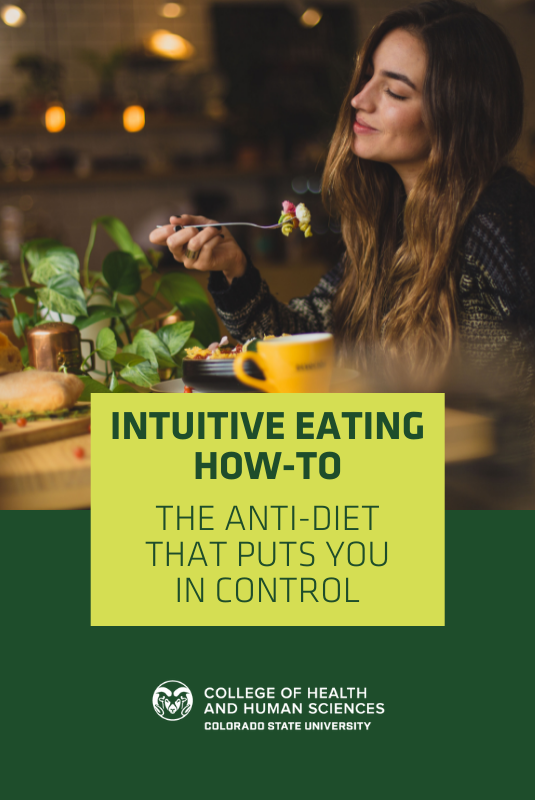 By Addie Cutler, CSU Marriage and Family Therapist Intern
By Addie Cutler, CSU Marriage and Family Therapist Intern
If you close your eyes and pay attention to your body, you might notice that it’s time for a snack and decide to head to the pantry. This is an example of intuitive eating, an anti-diet that places you as the expert on your body.
While research has only scraped the surface on intuitive eating, what we know so far shows promise. According to “The International Journal of Eating Disorders,” those who do more intuitive eating are less likely to have eating disorders and are more likely to have good body image. As this week is National Eating Disorder Awareness Week, take a moment to learn some tools for healthy eating behaviors.
What is intuitive eating?
Intuitive eating was first described by dietitians Evelyn Tribole and Elyse Resch who argued that we rely too little on our actual hunger and fullness and instead use things like diets or package size to tell us when, what, and how much to eat. Eating according to those external cues can take a toll when the main message is to eat less. Those who eat less than desired are more likely to express disordered eating attitudes and behaviors.
Intuitive eating offers a way to tap into our bodies’ intuition around what, when, and how much to eat. Notice that intuitive eating follows body autonomy, placing you as the only expert on your own body and its needs. What follows is a primer on what it looks and feels like to try intuitive eating.
The anti-diet how-to
Choosing what to eat. When choosing what to eat, intuitive eating says to mindfully listen to your body’s cravings. Try it yourself next time you go to choose a snack or meal by asking the following questions:
- Would I enjoy something hot or cold right now?
- Does a crunchy or soft snack sound good?
- If I imagine eating something sweet, does that feel satisfying? Does imagining savory flavors feel satisfying?
Choosing when to eat. With busy schedules, it can be difficult to notice when we are hungry or full. Intuitive eating encourages getting to know our own unique sensations and responding to them with compassion. Asking the following questions can be a great way to start:
- What does hungry feel like to me? Common examples include feelings of “I could eat” or low energy.
- How strong or loud does my hunger get before I listen?
Choosing how much to eat. Many diets instruct us on how much to eat based on serving size, calories, or macronutrient counts. Intuitive eating names you as the expert on your body, as it’s difficult to predict what your unique body needs to be nourished. When deciding how much to eat or when to stop eating, try asking these questions:
- What does fullness feel like to me?
- How do I know the difference between being a little full, satisfied, and uncomfortably full?
- When I’m eating, what body signals tell me I’m ready to stop?
If you’re curious to learn more about intuitive eating after trying the basics, check out Resch & Tribole’s book “Intuitive Eating: A Revolutionary Program that Works.” Additionally, some dietitians and therapists can help you dive deeper (look for those who are anti-diet or follow intuitive eating principles). If you find yourself preoccupied with food, body, or weight, reach out to the National Eating Disorder Association’s helpline or utilize their free screening tool to assess the next best step for you.
If you would like additional support navigating the realities of this time, the CSU Center for Family and Couple Therapy has registered counselors available to meet with you now. The CFCT is currently providing all Colorado residents low-cost individual, couple, and family online video sessions during daytime and evening hours to fit your schedule. To schedule an appointment, please call (970) 491-5991 or email cfct@colostate.edu.